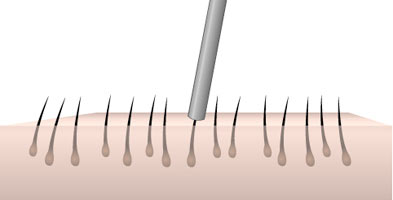
MAXIMUM DENSITY ?
Density is one the most demanded features of the hair transplantation. Density is important for covering the bald areas of the scalp. So it is concerned as much as design, hair growth rate and naturalness. Hair growth rate is closely related to density, because the needed and satisfactory density can be achieved by a high growth rate. If hair growth rate is kept as high as possible, then desired density and a good coverage can be provided.
What is important for density? This is an important question to see what affects the result of the hair transplantation in terms of density and how a surgeon can deal with it. As it is mentioned above, hair growth rate is an important factor, so how can a surgeon keep hair growth rate as high as possible? The answer is actually simple: Care, caution and experience. Grafts are just fragile units of hair follicles. So it is crucial to have great care and caution while working on them. Because from assistants’ holding point of the graft to the solution in which grafts are preserved during surgery, any factor in terms of the way of work and equipment are of vital importance for hair follicles. The more medical team have care and caution, the less they have risk of damaging a graft extracted.

Experience is another key factor which has great importance for the success of achieving desired density and satisfactory result of the hair transplantation. Like every profession the more it is practiced the more it develops and success becomes routine. Dr Keser and his team operate surgeries with that great care and caution to achieve the most satisfactory results for more than ten years. Before and after the surgery the care is always prioritized as well. Strategic and dense placement is also an important factor for high densities and Dr Keser always implants the grafts as close as possible to each other to provide a spaceless coverage on bald areas. Implantation technique as well as extraction he has is completely unique to him and based on care, caution for hair follicles. Because he has the awareness of the fact that graft care is one of the most important key concepts of a successful FUE hair transplantation.

The hair transplant surgery started in 1939 in Japan with a dermatologist, Dr. Okuda, who succeeded to develop a process of hair restoring in the injured and burnt areas of the scalp. The punch technique that he used included removing small parts of hair-bearing skin and implanting these into relatively smaller holes in the damaged skin areas. After the recovery of these grafts, the skin at issue was able to produce hair in the same area again.
A couple years later, another Japanese dermatologist, Dr. Tamura, developed Okuda’s technique and succeeded to minimize the size of the grafts, almost to one to three hairs each. He preferably worked on restoring the hair in the pubic areas of women. His surgery technique is nearly the same as the one that is being performed today.
The first hair transplant in the United States was accomplished by Dr. Norman Orentreich during the early 1950s for a man with male pattern baldness. Orentreich followed Okuda’s technique, yet the result was not as natural looking and attractive as expected, which was why his procedure came under much criticism. However, his procedure proved to be successful in preventing hair loss on the back and sides of the scalp.
By the 1960s, the hair transplant became more demanded in cosmedic fields. However, because past procedures underwent great misjudgment and negative reputation out of unattractive and unnatural appearances, the concept of hair transplant struggles to clear its name even today. As a matter of fact, it took more than a couple decades for hair plant surgeons but they did develop noteworthy improvements to these initial techniques.
In the 1990s, a new follicular unit transplantation technique was presented and affected the hair transplant area for good. Eventually, the old stains could be displaced and hair restoration could become practicable opportunity for those who suffer from hair loss.
Today, the studies on improving the hair transplant techniques are still carried out by surgeons. The techniques that we have today generate spectacular results and are embraced by hair loss sufferers more and more every day.
FUE
Follicular Unit Extraction (FUE) is known as a technique in which each follicular unit is extracted from the donor area by punch excision and then transplanted into the recipient area. The extraction process is done by a punch is usually less than 1 mm in diameter without damaging the follicular unit’s anatomic integrity.
The follicular units are harvested directly from the donor area, using a punch and thereby eliminating the need for strip excision. Goes back years to before 2000 (1), the definition and application of the technique in literature, became available after the studies, done by Rossmand and his friends in 2002.After this date, this technique has been known as FUE (2)
Follicular Unit Extraction (FUE) is a minimally invasive hair transplant technique in which follicular units are individually removed from the patient's donor area and individually transplanted to the recipient (thinning) area. The grafts are removed using an automated or manual extraction tool and then placed in the recipient area. No linear scar is left and no stitches are needed.
Just like with the traditional FUT (Follicular Unit Transplantation) or Strip method, FUE uses the harvesting of follicular units containing one to four hair follicles which are then transplanted to the areas of the scalp where more hair is needed. The follicular units are individually placed utilizing the time-tested Bosley process of natural graft placement. Natural graft placement ensures that the recreated hairline is tailored to the patient's hair-growth pattern to look and feel natural.
During the FUE hair transplantation procedure, individual follicular unit grafts are excised one at a time using a tiny one millimeter in diameter (or less) instrument. The device is used to make a tiny punch (circular incision) in the skin around the follicular unit to isolate the graft. The graft is then extracted directly from the scalp and prepared for implantation.
Typically, the patient's hair in the donor area where these grafts are being removed is clipped, cut short or almost shaved so that the physician is able to optimally visualize the patient's scalp.
The tiny incisions left behind after the follicle units are extracted heal completely in a few days. The tiny apertures contract as they heal, making the resulting round incision marks barely detectable.
FUE incorporates the latest minimally invasive technology and advanced grafting techniques. However, FUE is not for everybody and not always preferred by everybody. FUT remains the preferred method of hair transplantation for most patients. Only your physician can help you determine which technique is best for you.
Follicular unit extraction method is essentially a process of harvesting follicular units. The method involves the removal of the follicular unit. Extraction of the units is performed with specifically designed needles of various diameters and tips. FUE method is performed by Dr. Keser himself with great care with the help of his assistants. Dr Keser uses Follicular Unit Extractor which is a needle of less than 1-mm (0.7mm-0.9mm) diameter designed by Dr. Keser and patented by Turkish Patent Institute in 2003. An application for international PCT certification of the needle has also been filed. In transplanting the hair, it is possible to implant 60-80 follicular units (120-160 hairs) per cm2.

Prior to the extraction of follicular units, the hair in the donor area is shortened to the length of 1 mm. The donor area and recipient area are then locally anesthetized. The needle is held closer to the scalp so that the lumen points at the middle of the hair and is inserted as far as 6-7 mm at the growth angle of the hair and then pulled out. Therefore, the hair is cut out along with follicle and surrounding microscopic tissue in a cylindrical shape. It is then pulled out gently with a micropenset and the follicular unit is removed by extraction from the loose floor. After harvesting of follicular units by this method, they can be implanted with facility through much smaller holes inflicted on the hairless area.

The needles used in the extraction of follicular units were designed by Dr. KESER and approved by Turkish Patent Institute on September 16 2003 . For international patenting, a PCT application has been filed. These needles enable the removal of the hair with the surrounding microscopic tissue from the donor site without any damage to the hair root. The needles have a specially designed tip of 0.7-0.9 mm in diameter and are in a lumen(tube) form. About 6-8 mm distal part of the needle is inserted into the skin and withdrawn. This process resembles that of a complete removal of a plant with its root from the ground. Similarly, the hair and hair root is completely extracted from the scalp.
The grafts (FU) harvested through this process are then transplanted into the hairless area. In implantation process, not the needles mentioned above but the injection needles with 0.6-0.8 mm diameters are used.
The grafts are placed through very little holes inflicted by these needles. Since both the graft and implantation holes are too small, it is possible to achieve a denser transplantation (60-80 cm 2 ) and leave no scars on the skin.
We help you make your trip to Turkey as easy and hassle-free as possible. We offer free airport transfers from/to the airport with English speaking guide. We take care of arranging your accommodation for night of your hair transplantation. We will be happy to meet with you to discuss any questions you may have about a hair transplant in Turkey. Free Consultation...
For information about the latest and most modern fue hair transplant and hair loss treatment available, schedule your no-obligation consultation with Dr. Keser today. - Learn More about FUE...